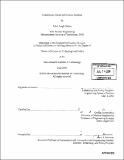Consistency checks in decision analysis
Author(s)
Outten, Juliet Leigh, 1977-
DownloadFull printable version (2.894Mb)
Other Contributors
Massachusetts Institute of Technology. Technology and Policy Program.
Advisor
George Apostolakis.
Terms of use
Metadata
Show full item recordAbstract
Given the range of events that can occur at a nuclear power plant throughout its lifetime, the appropriate course of action associated with addressing these events is equally variant. While the issues concerning quantification of the frequency associated with these events can be addressed using reliability models or PSA, the actual path and decisions made concerning the appropriate outcome is not readily obvious. Decisions are made on the basis of importance of cost, health and safety to the decision maker. These decisions include external influences, such as regulation and media attention, as well as internal influences. Using a formalized decision making process, the importance of these factors to the decision maker can be determined utilizing sets of weights and values for cost, health and safety (performance measures). Having assigned weights and values to each performance measure, an integral part of the decision making process is comparing assigned values to ensure consistency. It is useful to examine the "value of a life" in order to perform these consistency or "sanity checks." A case study is performed on decision making for a nuclear power plant and presented reflecting the data collection process for formal decision making with the aid of consistency checks. The formal decision methodology is completed by the consistency checks. Having established consistency checks and completed the analysis through their use, the consistency checks may be applied toward standing policy. Specifically, the Reactor Oversight Process, developed by the Nuclear Regulatory Commission to establish a more transparent procedure for assessing licensee performance, is paralleled to a formal decision making process. A proposal for the use of consistency checks in this established (cont.) policy is presented to promote a well-rounded and less subjective procedure.
Description
Thesis (S.M.)--Massachusetts Institute of Technology, Engineering Systems Division, Technology and Policy Program, 2004. Includes bibliographical references (leaves 81-82).
Date issued
2004Department
Massachusetts Institute of Technology. Engineering Systems Division; Technology and Policy ProgramPublisher
Massachusetts Institute of Technology
Keywords
Technology and Policy Program.